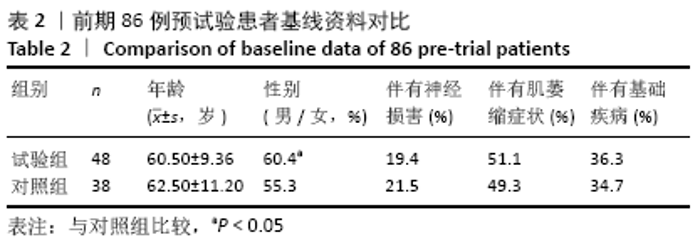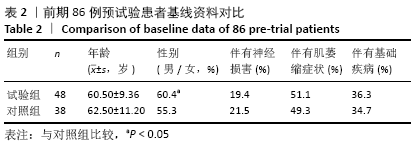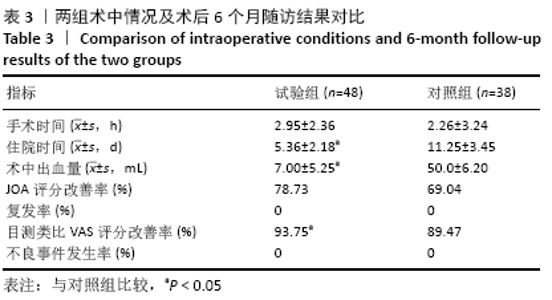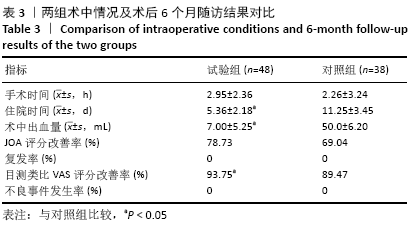[1] FENNER L, GAGNEUX S, JANSSENS JP, et al. Tuberculosis in HIV-negative and HIV-infected patients in a low-incidence country: clinical characteristics and treatment outcomes. PLoS One. 2012;7(3):e34186.
[2] KARAGEORGOPOULOS DE, ALLEN J, BHAGANI S. Hepatitis C in human immunodeficiency virus co-infected individuals: is this still a “special population”? World J Hepatol. 2015;7(15):1936-1952.
[3] MOSTHAF FA, HANHOFF NJ, GOETZENICH A, et al. High incidence of non-AIDS-defined cancers among HIV-infected patients in Germany. A 3-year nationwide review. Dtsch Med Wochenschr. 2006;131(34-35): 1849-1852.
[4] 杨团营,郑稼.椎间孔镜治疗腰椎间盘突出症50例疗效观察[J].中华实用诊断与治疗杂志,2016,30(5):490-491.
[5] 朱贤康,钟家云,李腾标,等.椎间盘镜下建立椎弓根钉通道行后路腰椎椎体间融合术临床研究[J].中国医药导报,2017,14(22):63-65,88.
[6] XU CH, WU ZH, CHEN RC, et al. Case-control study of therapeutic effects between extreme lateral interbody fusion and conventional posterior operation for the treatment of upper lumbar disc herniation. Zhongguo Gu Shang. 2017;30(11):994-999.
[7] 罗登科,周纳新,赵红卫,等.腰椎间盘突出症微创治疗的临床疗效分析[J].骨科,2017,8(6):439-444.
[8] 王瑞,霍喜卫,胡成栋,等.模块化减压法联合植骨融合内固定治疗腰椎间盘突出症效果分析[J].河北医科大学学报,2017,38(10): 1158-1162.
[9] 尚平福,魏凯,王黎昆,等.不同入路在高位腰椎间盘突出症减压植骨融合固定术中的效果及安全性[J].解放军医药杂志,2017, 29(8):18-21.
[10] 胡枫,张文志,李旭,等.微创与开放经椎间孔腰椎间融合术后邻近节段退变的比较[J].临床骨科杂志,2017,20(3):257-261.
[11] 李波.不同术式治疗腰椎间盘突出并腰椎管狭窄症疗效分析[J].北华大学学报(自然科学版),2018,19(2):231-234.
[12] CASIMIRO M. Short-term outcome comparison between full-endoscopic interlaminar approach and open minimally invasive microsurgical technique for treatment of lumbar disc herniation. World Neurosurg. 2017;108:894-900.
[13] WU GN, ZHANG SM, JIN J, et al. Percataneous endoscopic lumbar discectomy for the treatment of lumbar intervertebral disc protrusion. Zhongguo Gu Shang. 2017;30(9):861-865.
[14] SANG PM, ZHANG M, CHEN BH, et al. Treatment of migrated lumbar disc herniation with percutaneous endoscopic lumbar discectomy and target foraminoplasty. Zhongguo Gu Shang. 2018;31(4):302-305.
[15] LIANG H, CHANG L, CHEN R, et al. Independent and Combined Effects of Chronic HIV-Infection and Tobacco Smoking on Brain Microstructure. J Neuroimmune Pharmacol. 2018. doi: 10.1007/s11481-018-9810-9.
[16] NYONGESA MK, MWANGALA PN, MWANGI P, et al. Neurocognitive and mental health outcomes and association with quality of life among adults living with HIV: a cross-sectional focus on a low-literacy population from coastal Kenya. BMJ Open. 2018;8(9):e023914.
[17] PU L, LIU J, LUO Y, et al. Acute kidney injury in Chinese HIV-infected patients: a retrospective analysis from the intensive care unit. AIDS Patient Care STDS. 2018. doi: 10.1089/apc.2018.0040.
[18] VERGARI C, MANSFIELD J, MEAKIN JR, et al. Lamellar and fibre bundle mechanics of the annulus fibrosus in bovine intervertebral disc. Acta Biomater. 2016;37:14-20.
[19] SIVAN SS, HAYES AJ, WACHTEL E, et al. Biochemical composition and turnover of the extracellular matrix of the normal and degenerate intervertebral disc. Eur Spine J. 2014;23 Suppl 3:344-353.
[20] MCCULLOCH JA. Chemonucleolysis: experience with 2000 cases. Clin Orthop Relat Res. 1980;(146):128-135.
[21] PLOS ONE STAFF. Correction: comparison of the Japanese Orthopaedic Association (JOA) Score and Modified JOA (mJOA) Score for the assessment of cervical myelopathy: a multicenter observational study. PLoS One. 2015;10(5):e0128392.
[22] KNOP C, OESER M, BASTIAN L, et al. Development and validation of the Visual Analogue Scale (VAS) Spine Score. Unfallchirurg. 2011;104:488-497.
[23] YOON SM, AHN SS, KIM KH, et al. Comparative study of the outcomes of percutaneous endoscopic lumbar discectomy and microscopic lumbar discectomy using the tubular retractor system based on the VAS, ODI, and SF-36. Korean J Spine. 2012;9(3):215-222.
[24] 王森,刘欣春.经皮后外侧入路椎间孔镜下治疗硬化型腰椎间盘突出症的疗效分析[D].沈阳:中国医科大学,2017.
[25] MA XL. A new pathological classification of lumbar disc protrusion and its clinical significance. Orthop Surg. 2015;7(1):1-12.
[26] TAZAWA T, KAMIYA Y, TAKAMORI M, et al. Relationship between ventral lumbar disc protrusion and contrast medium leakage during sympathetic nerve block J Anesth. 2015;29(1):138-142.
[27] LI Y, FREDRICKSON V, RESNICK DK. How should we grade lumbar disc herniation and nerve root compression? A systematic review. Clin Orthop Relat Res. 2015;473(6):1896-1902.
[28] WU GN, ZHANG SM, LIU YZ, et al. Treatment of displacement-type lumbar intervertebral disc protrusion on L2-L5 with percutaneous endoscopic interlaminar discectomy. Zhongguo Gu Shang. 2018;31(8): 718-722.
[29] YU PF, LIU JT, MA ZJ, et al. Logistic regression analysis on the outcome predictive factors of ruptured lumbar disc herniation. Zhongguo Gu Shang. 2018;31(6):522-527.
[30] NING HX, YUAN YW, ZHANG QY, et al. Percutaneous transforaminal endoscopic discectomy and miniincision surgery in the treatment of lumbar intervertebral disc protrusion. J Biol Regul Homeost Agents. 2018;32(3):565-569.
|



